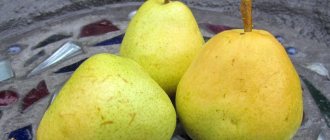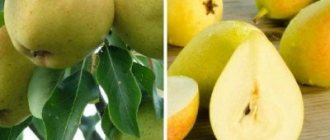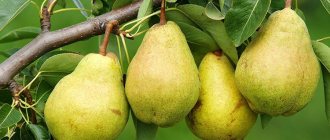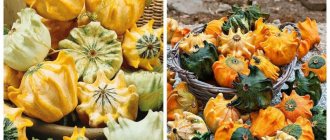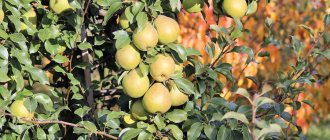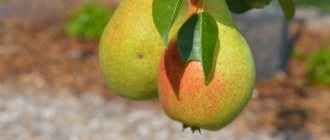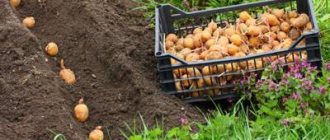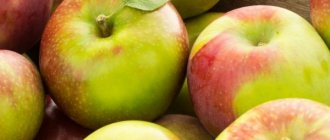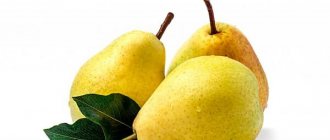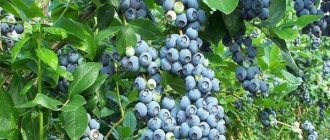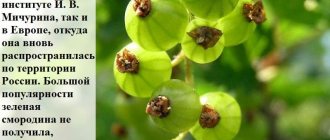The autumn variety Rossoshanskaya dessert is valued for its unpretentiousness, early fruiting, rich yield and juicy, tasty fruits. In order to grow a pear on your own plot, you need to know about the characteristics of the variety and tree care.
Dessert Rossoshanskaya pear is resistant to scab
The fruits are apple-shaped or short pear-shaped with a diffuse pink blush
History of selection
Back in 52 of the 20th century, at the experimental horticulture station of the same name, a new variety of pear was obtained, called “Dessert Rossoshanskaya”. The authorship belongs to two scientists - Neporozhny Georgy Dmitrievich and Ulyanishcheva Anna Mikhailovna. They crossed the late-ripening pear “Bere winter Michurina” and the variety of Belgian origin “Forest Beauty”. Since 1968, it began to be grown in various areas. But the best growing regions are considered to be the Bryansk region, the Voronezh region and the North Caucasus region.
We recommend reading an additional article that will tell you about popular varieties of pears.
Tips for the owner
- Pear does not like transplants , so it needs to immediately determine the sunniest and most protected place in the garden. In addition, when planting, you should take into account that the crown of the tree increases by 30-40 cm per year.
To protect it from spring melt water, the plant must be planted on an artificially created mound , raised above the general planting level.- Caring for the “Dessertnaya Rossoshanskaya” variety is no different from the requirements of agricultural technology for pear trees of Russian selection: pruning, watering, fertilizing, preventive spraying.
- Don’t expect to propagate this variety with seeds: everything will have to be grafted sooner. It is better to immediately take a strong rootstock with good heredity and carry out budding (grafting with an eye).
- The crown of a pear tree provides good shade, so it is advisable to plant it in a recreation area: above a bench or gazebo.
If you find an error, please select a piece of text and press Ctrl+Enter.
Sources:
https://sortoved.ru/grusha/sort-grushi-desertnaya-rossoshanskaya.html https://fermoved.ru/grusha/desertnaya-rossoshanskaya-opisanie-sorta.html https://selo.guru/sadovodstvo/grushi/ sorta-g/osennie-g/desertnaya-rossoshanskaya.html
Description
The tree is strong and medium-sized, grows with average intensity. It can reach a height of 6 meters. The crown is broadly pyramidal, but with sparse shoots.
The foliage is green. The leaves have a slightly curled tip. The leaf blade is medium in size and oval in shape. The flowers are small, up to 3 cm in diameter, snow-white, sometimes with a pink edge, medium-double and cup-shaped. Umbrella inflorescences consist of 8-9 flowers. The petals have smooth edges and are close to each other.
The average weight of one fruit is 150 g, but rarely exceeds 205 g, that is, they are of average size. In shape they can be round, apple-shaped, short pear-shaped or flat-round. The surface is smooth without roughness.
Ripe pears suitable for eating are colored light yellow and covered with a barely noticeable, blurred pinkish blush. Large subcutaneous dots are scattered throughout the fruit. They are usually either gray or green in color. The peduncle is medium long and curved. The pear pulp is white or light cream, medium-dense, tender and juicy, aromatic with a sweetish taste, no sourness.
Advantages and disadvantages of the variety
The variety is valued for the following advantages:
- undemanding to soil;
- early fruiting;
- the tree bears fruit annually;
- good yield;
- has immunity to scab;
- the fruits are transportable and have good shelf life;
- have excellent commercial qualities and versatility.
Disadvantages include:
- self-sterility, the pear needs helper pollinators;
- frost resistance indicators depend on the growing region, in the southern regions they are high, in the northern regions they are average;
- the flowers do not tolerate prolonged spring frosts; at a temperature of -2°C they freeze and die.
Main characteristics
The Dessertnaya Rossoshanskaya variety is a medium or vigorous fruit tree, the height of which can exceed 5 m. The bark of the trunk is gray-brown. A young tree is smooth, but cracks appear over the years. The skeletal branches are dark brown and characterized by oblique-vertical growth. Shoot formation is weak.
The crown is broadly pyramidal, not too thick. The leaves are medium sized, elongated oval with a pointed apex, slightly folded in half. Glossy, smooth, bright green. The lower part has a lighter shade.
The flowers are white, relatively small in size (about 3 cm) with closed petals. They are located on medium-length stalks. Collected in inflorescences of 7-9 pieces. Flowering occurs in early to mid-May, depending on the weather. The later the tree blooms, the greater the likelihood that the flowers will not encounter return frosts.
The variety is autumn. Its fruits ripen by early September (in the south of the Central Black Earth region). They develop on short fruiting branches - ringlets, which develop mainly on 2-year-old shoots.
The frost resistance of the fruit tree is above average. Tolerates frosts typical of temperate continental climates. However, prolonged spring frosts can destroy the flowers. Under severe winter conditions in the north of the Voronezh and Lipetsk regions, freezing of the buds was repeatedly observed.
The plant has excellent resistance to scab. During all the years of cultivation of the variety, the development of this disease was not observed. In some years, infection with septoria leaf blight may occur.
Planting dates, location and soil preparation
The best option is an area closed from wind and drafts. The pear is undemanding when it comes to soil, but still grows better in fertile loamy soils. The plant does not do well on clay soils. Do not lose sight of the acidity of the soil. It must be either slightly acidic or neutral. The tree responds favorably to liming of strongly and moderately acidic soils.
The pear does not like excess moisture, so choose areas where groundwater is at a depth of at least 3 m. The tree has a long root system; it will grow better on dry soils than on wet soils. With excess moisture, the roots suffer from a lack of oxygen. The tree trunk circle must be loosened regularly.
A universal variety for gardeners in Central Russia - Pear “Dessert Rossoshanskaya”
Although the pear ranks third in domestic gardens after apple and cherry trees, it appeared there as an overseas guest: heat-loving, sensitive to drought and frost, defenseless against fungal parasites.
According to the evidence of the literary works of ancient Hellas and Sumerian medical treatises, this plant has been known to mankind for many thousands of years, but the pear’s finest hour was the 18th century, when people started thinking about the cultivation and assortment of this rose flower.
Step by step planting process
Experts recommend purchasing varietal seedlings in specialized stores or nurseries to avoid disappointment later. Buying planting material secondhand is always a risk, since the seller can sell anything under the name of this variety. Before planting, the branches and roots of the seedling are cut off.
Step-by-step instruction:
- First they prepare the seats. The optimal pit size is 70 cm in diameter and about 1 m in depth.
- Humus, compost or rotted manure (20-30 kg) and mineral fertilizers - superphosphate (800 g), potassium chloride (100 g) are added to the dug soil, the latter can be replaced with 1 kg of wood ash and lime (1-1.5 kg ). The amount of lime added depends on the acidity and structure of the substrate. The bottom is loosened.
- A stake is driven into the center of the recess and a layer of soil is filled in so that a mound is formed.
- The soil in the pit is well compacted.
- The seedling is placed in a hole, carefully spreading the roots over the surface of the mound.
- The root collar is positioned so that it rises 4-6 cm above the surface.
- The planting hole is completely filled with the remaining soil and compacted well.
- Make a hole around the tree and pour out 2 buckets of water.
- The surface of the soil is covered with mulch - peat, mowed grass or humus.
Pear care
The main components of care are the organization of proper watering, pruning and timely application of fertilizers.
Watering
The Rossoshanskaya dessert pear does not tolerate drought well, so it needs timely watering, but the tree should not be flooded. In severe drought, the fruits become small, and when waterlogged, the plant's growth slows down and it may shed its leaves prematurely. Water the pear when the soil dries out, pour out up to 2-3 liters of warm water per 1 square meter. m of tree trunk circle. Be sure to water during the period of ovary formation, fruit filling and after harvesting.
Trimming
Due to the sparse crown, pruning is not required in the first 2-3 years. Then sanitary and formative pruning is carried out. The branches are transferred to the outer branch. Only large branches are cut out of a fruiting pear.
Fertilizers
Every spring, ammonium nitrate is added by digging a trench along the edge of the tree trunk circle. At the rate of 20 g of fertilizer per 1 sq. m. Once every 3 years in the fall, add 50 g of superphosphate and 20 g of potassium sulfate or organic matter - 0.5 buckets of manure.
Planting, growing care
Following the rules of agricultural technology will allow you to get a bountiful harvest of tasty fruits.
Landing
After proper planting in the spring, during the first month, the plants should be watered twice a week (but no more), one bucket of water per tree.
After planting is completed, young plants continue to be watered regularly, the soil is mulched to 10 cm, and pruning is performed. In dry weather, watering volumes are increased. Is it possible to plant a pear next to a plum? This material will tell you.
In order for the crop to take root properly, the soil will need to be thoroughly moistened before planting. The soil should be moist down to the depth of the seedlings.
Deadlines
Planting of seedlings should be carried out taking into account the time of year. It is recommended to plant young trees in the spring. In autumn, the procedure is rarely carried out, since the ability of seedlings to take root deteriorates. If you still have to do it in the fall, do it before frost sets in.
Technology and agricultural technology
Dessert Rossoshanskaya pear should be planted in southern areas, protected from drafts. Any soil can be used, but trees grow better in nutritious soils. The holes for the roots are prepared in advance by filling them with loose soil. The root collar is placed strictly above the soil surface. Carefully cover the roots with soil and carefully trample the mound. After planting is completed, a hole is created around the trunk - an earthen roller around the trunk. Also read about the decorative pear in this article.
Watering should be regular and sufficiently abundant. After planting, use 2-3 buckets per plant. When the moisture is absorbed, the tree trunk circle is mulched. It is also recommended to tie up young trees.
What is the best thing to grow from?
To plant a garden, use seedlings; one- and two-year-old plants have the maximum survival rate. Take planting material from trusted places, or even better, from nurseries. Trees older than two years should not be taken, as they take root very poorly.
Distances between trees
Since the trees are medium-sized, it will be enough to leave 3-4 meters between them. The optimal distance between rows is 5-6 meters. Do not thicken plantings, as this leads to the development of various diseases and reduces yields.
Care
Garden care involves protection from frost, application of fertilizers, regular digging of tree trunks, loosening of soil, moderate watering, removal of weeds and shoots, prevention of diseases and pests. Crown formation is usually natural, but additional pruning is often required. Rejuvenating procedures are done after a year and only for mature trees. Removing old shoots and branches that do not bear fruit and grow towards the trunk is mandatory. Preventive treatments against the winter moth, pear weaver, fruit weaver (zolon, karbofos, actellik, pine concentrate), digging up the soil around the trunk, collecting caterpillars, and burning infected fruits are recommended.
Fruit ripening
Dessert Rossoshanskaya pears ripen from the beginning of September (much depends on the climate of a particular region). It is better not to leave them on the branches - otherwise the fruits will begin to fall, become damaged, and their shelf life will decrease. Fruits should be picked as they reach maturity.
Feeding
Organic matter is applied in the fall, nitrogen fertilizers in the spring. Pears need nitrogen most during active growth. Organic fertilizing is done annually or every other season. Foliar fertilizers are applied after flowering and during fruit growth (15 g of bromine per bucket of water), the average number of root dressings per season is five (early and late autumn, early spring, flowering period, May).
Fruit storage
The fruits reach ripeness in early September; the period of pear consumption lasts until November. The variety is highly productive, the fruits are strong and can withstand transportation well. The harvest is removed from the trees manually - if the branches fall while shaking, the fruits are damaged and quickly deteriorate. Pears need to be picked with the stem intact. To store the harvest, use wooden or plastic boxes, the bottom of which is covered with paper. Pears can be laid in two to four layers, each layered with paper sheets or covered with wood shavings.
Rejuvenation
Rejuvenating pruning extends the life and fruiting of mature trees. First, the central trunk is cut off, then the skeletal and semi-skeletal branches are removed, the sections are coated with garden varnish or drying oil. Pruning is done from the west or south. After a year and a half, remove a few more skeletal, semi-skeletal branches. New summer branches are partially pinched and partially removed, leaving a distance of 20-10 cm between the tops. In August, large shoots are bent on the sides, the strongest ones are left. That is, the rejuvenation procedure takes 2-3 years. Read about pear grafting in spring for beginners here.
There is no need to remove too many branches - this can lead to the formation of dying roots and death of the tree.
Pruning
Young pears do not require significant pruning, since their crown forms naturally. The side shoots are left as is, the tops are removed only when necessary, frozen ones. Do not remove everything - otherwise the fruiting rates will drop.
Preparing for winter
In autumn, pear trunks are whitened with lime and protected from the teeth of rodents using a piece of roofing felt or nylon mesh. To be on the safe side, traps with “treats” are also placed around the area.
There is no need to protect mature trees from frost. Only young seedlings are covered. They are completely wrapped in paper or an individual cone is made for each one from a modern covering material - spunbond - and covered with it. The tree trunk circle is mulched with sawdust or dry soil; the mulch layer should be quite thick - at least 15 cm.
Diseases, pests and prevention
This variety has excellent immunity to various diseases and rarely suffers from insect attacks. However, the variety is not immune to some pests. The main pear diseases, their symptoms and preventive measures are listed in the table.
| Diseases/pests | Signs | Prevention |
| Winter moth | Harm is caused to the plant by its larvae, which gnaw out all parts of the plant - buds, branches, flowers, leaves. From the latter, only veins remain and often they are entangled in a web in which the caterpillar lives. | They dig up tree trunk circles in the fall; destroy caterpillars and spider nests manually. They clean the trunk of moss and be sure to whiten them in spring and autumn. |
| Pear moth | Unripe pears begin to drop prematurely and rot. | They set traps, dig up the soil in the fall, manually collect the pest, and burn fallen fruits. |
| Pear weaver sawfly | A small yellow spot first appears on the skin of the fruit, which begins to grow rapidly over time. The fruit turns brown, and whitish or creamy pads appear on its surface. The quality of the pulp deteriorates, it loses its taste and becomes loose. Rotten fruits fall off or remain hanging on the branches in a mummified form. The disease is transmitted from sick pears to healthy ones. | All fallen fruits are destroyed; all diseased fruits must be removed from the branches and disposed of. The tree is treated with 4% Bordeaux mixture until the buds wake up. In summer they spray with the same product, but in a lower concentration - 1%. |
| Rust | The leaf blades are covered with spots of a round shape and red color. At first they are small, then they increase in size. In advanced cases, star-shaped growths form on the leaves. Infected leaves fall off. | Before the buds open, spray the tree with 4% Bordeaux mixture. Collect and burn all infected leaves. Loosen the soil around the pear. |
| Cytosporosis | Red brick-colored spots form on the bark. Damaged areas crack and become flabby. The branches dry out and die. | Comply with agricultural practices. The sections are lubricated with garden varnish. Try not to damage the bark. |
Varieties
There are 4 varieties of Rossoshanskaya pear, which differ in the ripening period and appearance of the fruit.
Dessert pear Rossoshanskaya
The hybrid was included in the State Register in 1965. Pears are recommended to be grown in the Central and Central Black Earth regions.
The culture has the appearance of a medium-sized tree. The variety has a rounded crown with medium density. The bark is gray, the shoots are brown. The leaves are green, large, with pointed tips. The leaf blade is smooth and curved. The flowers are white, large.
The fruits have a flattened shape and weigh about 190 g. The skin is smooth, not hard, light yellow with a crimson blush. The pulp is slightly dense, beige, and produces a lot of juice. It tastes sweet and sour, with a faint aroma. Tasting properties are rated 4.5 points. The fruits are well transported, the shelf life is from 100 to 146 days. Application - universal.
The Dessertnaya Rossoshanskaya variety has high winter hardiness. When the temperature dropped to -38 °C, freezing was 1.4-1.8 points. These are mild injuries in which some of the generative buds and annual shoots die.
The tree tolerates drought well. During the growing season it is damaged by septoria and copperhead. Scab resistance is high.
Pear Rossoshanskaya Beautiful
The Rossoshanskaya Krasivaya variety was obtained by crossing the Tonkovetka Mlievskaya variety and Lyubimitsa Klappa. In 1986 it was entered into the State Register. The variety is widespread in the southern regions of the Black Earth Region, the North Caucasus and the Volga region.
The trees are vigorous and have a pyramidal crown. The crown is sparse, the bark is dark gray, the skeletal branches are brownish. The shoots are long and straight. The leaves are green, shiny, medium sized. The buds are pink and white.
The fruits of the Rossoshanskaya Krasavitsa pear are medium in size and weigh 120 g. The shape is pear-shaped and elongated. The skin is smooth, non-rigid, white-yellow, covered with green dots. The color is blurry, red. The inside of the pear is yellowish, juicy, sweet with a sour aftertaste. The variety was given a tasting score of 4 points. The fruits hang on the branches for a long time before ripening. The pear is well stored and transported.
The winter hardiness of the variety is high. At a temperature of -34 °C, the degree of freezing of shoots is up to 1.3 points. Drought resistance is average. If there is a lack of moisture, the fruits become smaller. The inflorescences do not tolerate spring frosts.
Important! When the temperature drops to -2 °C, the flowers of the Rossoshanskaya variety fall off.
Scab resistance is average. In the conditions of the Voronezh region, a tree rarely gets sick. More often, signs of the disease appear when planting in the Oryol region.
Pear Rossoshanskaya Late
It is considered one of the best among winter varieties. The fruits are enlarged, weighing 250 - 350 g. The shape is round, the color is yellow-green. When ripe, the skin turns yellow. When exposed to the sun, a red blush appears.
According to the description, the Rossoshanskaya Late pear has a good taste and presentation. The pulp is beige, tender, with a pronounced aroma. The harvest is harvested in mid to late September. Storage period - until February. If you remove the fruit later, the pulp picks up more sugar. This reduces the storage time of the pear.
The tree is medium-sized, has a rounded crown. Winter hardiness is high; at a temperature of -32 °C, freezing is estimated at 1.5 points.
Pear Rossoshanskaya Early
The variety was obtained by cross-pollination of Mramornaya and Rossoshanskaya Krasivaya pear seedlings. Varietal testing has been taking place since 1995. Tree of medium to high vigor. The crown is not thickened. The bark on the trunk is dark gray.
The shoots are brown in color and branch weakly. The leaves are ovoid, green, shiny, curved along the vein. Umbrella-shaped inflorescences with white flowers.
The fruits are elongated and medium in size. The skin is smooth, golden yellow. Most of the pear has a red-orange blush. The surface is covered with small subcutaneous dots. The taste is sweet and sour, rated 4.7 points. The pulp is yellowish, tender, oily.
The Rossoshanskaya summer pear tolerates temperature drops in winter down to -30 °C. Cold snaps in the fall are more dangerous for the tree. The variety also does not tolerate spring frosts.
Collection, storage and transportability
The fruits are picked green (unripe) and left to ripen until consumer ripeness - the color of the fruit becomes yellow and covered with a pinkish blush. Ripe fruits are stored for no more than 78 days - usually until November.
Pears are removed from the tree by hand, tearing off each fruit with a stalk. But you shouldn’t shake the fruits from the tree, because when they fall, dents and damage will form. The fruits are transportable; they can be transported over long distances without loss of appearance and quality.
The harvested crop is placed in wooden or plastic boxes in a dark place with a temperature of 0°C. Be sure to lay several layers of paper at the bottom of the container, but not newspapers. Pears are laid in several rows with the stem diagonally so that they do not damage each other. Each row is laid with paper or sprinkled with dry soft shavings and calcined sand.
You can see what the Dessert Rossoshanskaya pear variety looks like in the video below:
The fruits of this variety are universal. They are suitable for compotes, since the pulp does not boil over and retains its shape; candied fruits and jams are prepared from them and eaten fresh.
Use of fruits
There are no greater connoisseurs of the taste of pear fruits in the world than the French. In their national cuisine there are countless simple and complex dishes made from this fruit. They also know best how to eat it with the greatest benefit and pleasure. Here are the recommendations they believe should be followed:
Reviews from gardeners
In most cases, gardeners speak well of this pear variety:
★★★★★
Evgeniy Vasilievich, 65 years old, Moscow. I have been growing Rossoshanskaya for a long time, I like it.
You don’t need to put in any special care efforts, do everything that is required and you will get the result - delicious fruits. I like its taste, it is unsaturated, blandly sweet, but this is a subjective point of view, since, as you know, there is no friend for taste and color. ★★★★★
Anastasia, 42 years old, Tver. I have no complaints about this variety, the only small drawback I consider is that the overripe pulp resembles boiled potatoes.
And so, in general, I like everything. As for me, this is one of the most successful varieties of pears. ★★★★★
Larisa, Moscow
Excellent variety of pear. Large, sweet. Not only we like it very much, but also the wasps, we have to save the fruits. The fruits lie quietly for a couple of months and remain juicy and tasty. Caring for the tree is simple, but the harvest is serious. It is better to buy from trusted nurseries to avoid fakes. The tree is seven years old, occupies a place of honor in the garden and is in its third year with a harvest.
★★★★★
Vladimir Mr. Bobrov
An excellent variety of pear. It bears fruit every year, but this year the fruit weighed 350-430 grams, they were surprisingly juicy and tasty!
Hide
Add your review
Rossoshanskaya dessert pear is an excellent option for a personal plot or a large garden. With proper care, it will delight every year with large harvests, and the delicious aromatic fruits will appeal to pear connoisseurs.
0
0
Copy link
Reviews of Rossoshanskaya pear
Kuznetsov Vasily Petrovich, 48 years old, Voronezh
The Rossoshanskaya Dessert pear has been growing on my plot for more than 8 years. I grafted the variety onto a wildflower seedling. During this time, the height of the tree did not exceed 2.5 m. The yield was high and stable. 3 - 4 pears are tied in a brush. Sometimes scab appears on the leaves, but the fruits do not suffer from disease. If you process it regularly, there will be no problems with this. The winter hardiness of the tree is high; the wood is not damaged after cold weather. The taste of the fruit is excellent and is perfect for processing.
Ermolina Maria Alexandrovna, 54 years old, Belgorod
I recommend Rossoshanskaya Krasivaya pear to lovers of sweet varieties. The pulp is juicy and oily. The taste is sweetish with pleasant sourness. The tree is unpretentious and stable. The harvest ripens in mid and late August. The variety is partially self-fertile, so its yield is always high. The fruits are reddish, have a good presentation and weigh about 150 g. I constantly spray the garden against diseases, so the tree always looks healthy.
